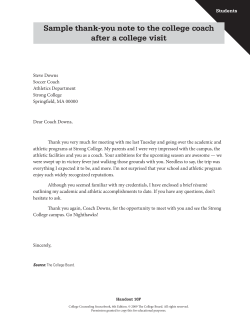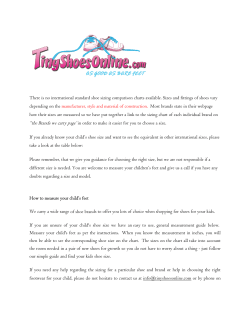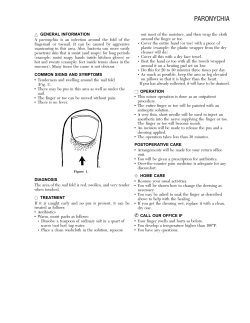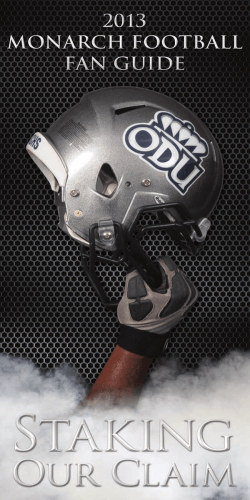
Foot Injuries Arches
Arches Foot Injuries • Three arches in the foot: 1) Lateral longitudinal arch 2) Medial longitudinal arch 3) Transverse arch • These arches are maintained and supported by the wedging of the interlocking tarsal and metatarsal bones, tightening of the ligaments of the plantar aspect of the foot, and the extrinsic muscles of the foot and their tendons.1 1. Magee. Orthopedic Physical Assessment. 2002. Medial Longitudinal Arch Lateral Longitudinal Arch • Bones: Calcaneal tuberosity; Talus; Navicular; three Cuneiforms; first, second, and third Metatarsals1 • Supported by the tibialis anterior, tibialis posterior, flexor digitorum longus, flexor hallucis longus, abductor hallucis, and flexor digitorum brevis muscles, along with the plantar fascia and the plantar clacaneonavicular ligament.1 • Bones: Calcaneus; Cuboid; fourth and fifth Metatarsals • Supported by the peroneus longus, peroneus brevis, peroneus tertius, abductor digit minimi, and flexor digitorum muscles, along with the plantar fascia and the long and short plantar ligaments.1 1. Magee. Orthopedic Physical Assessment. 2002. 1. Magee. Orthopedic Physical Assessment. 2002. Transverse Arch • Bones: Navicular, Cuneiforms, Cuboid, Metatarsal bones1 • Supported by the tibialis posterior, tibilais anterior, and peroneus longus muscles, along with the plantar fascia.1 1. Magee. Orthopedic Physical Assessment. 2002. Arch Strains • An arch strain could be caused from an excessive jerk, twist, bend, plantarflexion, or dorsiflexion to any of the muscles or ligaments supporting the arches.1 • Treatment: Rest. Ice. Arch support system/brace or arch tape for extra support. Time off of sport related activity depends on the severity of the strain.1 1. Magee. Orthopedic Physical Assessment. 2002. 1 Plantar Fascia • Thick white band of fibrous tissue originating from the medial tuberosity of the calcaneus and ending at the proximal heads of the metatarsals.2 2. Prentice. Arnheim’s Principles of Athletic Training: A Competency-Based Approach. 2003. Plantar Fasciitis • Inflammation of the Plantar Fascia. Usually caused by overuse and irritation.1 • Normal movements and ROM with pain (localized or radiating) in the anterior medial heel. Sometimesparesthesia in the sole of the foot will appear. Pain worsens after long periods of standing, walking, or running, or if foot is forced into dorsiflexion.1 1. Magee. Orthopedic Physical Assessment. 2002. Plantar Faciitis • Treatment: the best treatment is orthotic therapy. A night splint may also be used to help maintain a static stretch. Athlete should maintain a stretching routine to add additional stretching. Anti-inflammatory medications are recommended.2 2. Prentice. Arnheim’s Principles of Athletic Training: A Competency-Based Approach. 2003. 2 Heel Bruise (Contusion) Heel Bruise (Contusion) • Thick fat pad covering calcaneus bruises from sport activities that demand a lot of stop-and-go or sudden change from horizontal to vertical (e.g. basketball, volleyball, track and field, etc…)2 • Symptoms: unable to apply pressure to, or weight-bear on, the heel. Sometimes you may notice redness or the heel may feel warm.2 • Treatment: athlete should not bear weight for 24 hours. RICE should be taken into affect. Anti-inflammatory medication are administered to help bring down the swelling. A heel cup or protective doughnut should be applied.2 • 2. Prentice. Arnheim’s Principles of Athletic Training: A Competency-Based Approach. 2003. 2. Prentice. Arnheim’s Principles of Athletic Training: A CompetencyBased Approach. 2003. Sprained Digit Sprained Digit • Pathology • Treatment – Tearing of the ligaments in the toes – RICE – casting/splinting – Buddy taping – Weight bearing and activity as tolerated1 • Mechanism – Excessive flexion, extension, or twisting of the toes – Kicking an unyielding surface1 1 Prentice, William E. Arnheim’s Principles of Athletic Training, 2003 1 Prentice, William E. Arnheim’s Principles of Athletic Training, 2003 Exostosis Exostosis • Pathology – a.k.a bone spur – An abnormal bony outgrowth extending from the surface of the bone – An increase in the bone mass at the site of an irritative lesion in response to overuse, trauma, or excessive pressure1 1 Magee, David J. Orthopedic Physical Assessment. 2002 2 www.podiatryinfo.com/ vphtml/heel.html • Mechanism 2 – Repeated strain placed on a bone or the bony insertion of a tendon1 • Treatment – RICE – Donut padding – Surgical intervention2 1 Magee, David J. Orthopedic Physical Assessment. 2002 2 Prentice, William E. Arnheim’s Principles of Athletic Training, 2003 3 Tarsal Tunnel Syndrome Tarsal Tunnel Syndrome 2 • Pathology – Entrapment of the posterior tibial nerve or one of its medial or lateral branches as it passes through the tarsal tunnel1 • Mechanism – Compression – Fracture, dislocation, or inflammation of the tarsals or local ganglion • Treatment – Orthotic – Surgical intervention1 1 Starkey, Chad. Ryan, Jeff. Evaluation of Orthopedic and Athletic Injuries, 2002 2 www.footcaredirect.com/ tarsal_tunnel.html 1 Starkey, Chad. Ryan, Jeff. Evaluation of Orthopedic and Athletic Injuries, 2002 Ingrown Toe Nail Bunions • Pathology: • Pathology: – Inflammation of the bursa over the 1st metatarsophalangeal joint causes the hallux to become deformed – The toe nail grows into skin, cutting the flesh. • MOI: • MOI: – Trimming nail too short – Small shoes http://www.cgh.com.sg/health_public/pamphl et/general/nail/nail_content2.html • Treatment: – Narrow shoes – Pronated foot – Depressed or flattened trans arch http://www.americasfootdoctor.com/yourfeet_bunions.shtml • Treatment: – Remove excess nail – Place sterile object, i.e. cotton to push nail away from skin1 – – – – Wear wide box shoes Orthotics Pad or splint w/ wedge Surgery1 www.footandheel.com/topics/bunions.htm 1 http://www.cgh.com.sg/health_public/pamphlet/general/nail/nail _content2.html http://www.podiatryclinician.com/prod01.htm 1 Prentice. Arnheim’s Principles of Athletic Training. Blisters Callous and Corns • Pathology: • Pathology: – Fluid filled sacs covered with a thin layer of almost transparent skin – Thickening of skin as a result of friction • MOI: • Callous = bottom of foot • Corns = Top of foot – Improper footwear – Foot structure or gait patterns – Tape • MOI: – Rubbing against shoes http://images.search.yahoo.com • Treatment: • Treatment – Clean blister and try not to pop it – If popped…keep area clean – Wear different shoes – Cover with moleskin e.g. – Pads1 • Cover blisters and apply disinfectants http://www.family-foot.com/foot_ailments/corns_calluses. 1 http://www.family-foot.com/foot_ailments/corns_calluses. 1. “Caring for your Feet.” Our Health Network. Retrieved August 31, 2005, from http://www.ourfootdoctor.com/yourfeet_injuries_feet_b.shtml 4 Neuroma Plantar Flexed First Ray • Pathology: – Swelling of a nerve – The most common nerve affected connects the 3rd and 4th toes • Pathology: – Structural deformity occurs when the big toe lies lower then the other four metatarsal bones • MOI: – Over Pronation – The pulling of the ligaments under the foot irritates the nerve – High heels • MOI: http://images.search.yahoo.com – Poor biomechanics • Pes cavus – Genetics • Treatment: • Treatment: – Orthotics – Dorsal Osteotomy – Orthotics – Inflammatory injections – In severe cases, surgery may be necessary • Surgical repositioning of the bone 2. “Neuroma.” Dr. Foot. Retreived August 31, 2005, from http://www.drfoot.co.uk/neuroma.htm. 3. Magee (2002). Orthopedic Physical Assessment. Saunders, Inc. Pg. 787. Mallet Toe • • • Claw Toe Pathology: caused by a flexion contracture at the DIP joint involving the flexor digitorum longus tendon. – Mallet toe usually becomes a fixed deformity, causing the callus dorsally over the DIP joint or on the tip of the toe. development of a Mechanism of injury: wearing shoes that are too small over ayalenewhavenhealth.org/ long period of time. library/healthguide/en... Treatment: – Conservative treatment – Surgery • • • • • http://images.search.yahoo.com Focusing on relieving pressure by wearing loose footwear Padding can help with irritation Shave the callus Necessary when deformity becomes fixed Involves straightening the toe using a K-wire, inserted through phalanges into metatarsals • Pathology: caused by flexion contracture at the DIP joint but also involves hyperextension at MP joint. http://yalenewhavenhealth.org/library/healthguide/en-us/support/topic.asp?hwid=hw143095 – Callus develops over PIP joint and under the metatarsal head. ¹ • Mechanism of injury: wearing shoes that are too small over a long period of time. – Can be associated with Pes Cavus • Treatment: – Same as Mallet Toe www.federatie-pas.nl/ kompas/hfdst10-1.html Arnheim Principles of Athletic Training, Prentice, 2003 Arnheim Principles of Athletic Training, Prentice, 2003 ¹ Physical Examination of Spine and Extremities, Hoppenfeld, 1976 Turf Toe Sprained Hallux (Great Toe) www.athleticadvisor.com/.../ turf-toe_images.htm • Pathology: stretching or tearing of the ligaments or joint capsule in the first phalange • Mechanism of injury: force applied to extend joint beyond normal range, jamming it or twisting it – Example: kicking a stable object • Treatment: – RICE- reduce swelling – Buddy tape to adjacent toes to immobilize • Toes are too small to splint or cast!! • Most common example is turf toe. Arnheim Principles of Athletic Training, Prentice, 2003 • Pathology: hyperextension of the MP joint of the great toe resulting in a sprain. • Mechanism of injury: occur on synthetic turf because shoes designed for this field are more flexible and allow dorsiflexion of first toe. • Treatment: – – – – Ice Ultrasound Rest, until able to play without pain Shoe companies have added steel to forefoot areas to decrease this injury or you can add Orthoplast under the shoe insole www.amazon.com/gp/browse. html?_encoding=UTF8&... Arnheim Principles of Athletic Training, Prentice, 2003 5 EQUINUS DEFORMITY • Pathology – occurs when there is less than 100 of dorsiflexion in the ankle1 • MOI – results from contracture of the Achilles tendon or gastrocnemius or soleus muscles. Can also result from structural bone deformity1 1. Magee, David. Orthopedic Physical Assessment 4th ed. Pg. 781 http://www.worldortho.com/inventions/cripple/c111.html (picture) • Treatments – heel lifts, foot orthodics, shoe modification, physical therapy or surgery2 • All treatments are based on severity of deformity. 2. Prescription Custom Foot Orthoses Practice Guidelines, The American College of Foot and Ankle Orthopedics and Medicine. December 2004, pg 17 http://www.footmaxx.com/clinicians/five.html#equinus (picture) Pes Cavus • Pathology – the longitudinal arches of the foot are accentuated all the way to the toes3 • Treatments – orthodics, lateral wedge, stretching of the Achilles tendon and plantar fascia3 – Can cause claw foot3 – Results from excessive supination3 • MOI – cause of deformity is caused by abnormal orthopedic or neurological condition3 3. Prentice, William, Principles of Athletic Training 11th ed. Pg 510 3. Prentice, William, Principles of Athletic Training 11th ed. 2003 www.ordesignslv.com/ cmt.html (picutre) http://www.global-technologies.net/ShopSite/Extremities.html (picture) Pes Planus • Pathology – the medial longitudinal arch is flat3 – Excessive pronation of the feet3 – “flat feet” • Treatments – if there is no pain with the athlete, then nothing should be done to correct the problem3 – If athlete experiences pain, a properly constructed orthodics should be used3 – A medial wedge should be used to correct excessive pronation3 • MOI – overweight3 – Wearing of tight shoes – Trauma that weakens supportive structures3 3. Prentice, William, Principles of Athletic Training 11th ed. 2003 http://www.global-technologies.net/ShopSite/Extremities.html (picture) 3. Prentice, William, Principles of Athletic Training 11th ed. 2003 www.supportyourfeet.com/ over_pronation.htm (picture) 6 REARFOOT VARUS • Pathology – inverted calcaneus relative to the long axis of the tibia4 • Treatments – depending on severity of the problem, orthodics would be used to treat the deformity4 – Subtalar joint is in neutral poistion • MOI - heel spur syndrome, Tailor’s bunion, leg fatuige4 4. http://www.footmaxx.com/clinicians/five.html REARFOOT VALGUS 4. http://www.footmaxx.com/clinicians/five.html • Treatments – orthodics with a control in the rear foot5 • Pathology – the calcaneus is inverted relative to the long axis5 – Rarely observed – Valgus tibial alignment • MOI – the rear foot becomes hyper mobile5 – Increased pronation – Hammer toes – Lateral ankle pain 5. Starkey, Chad. Evaluation of Orthopedic and Athletic Injuries 2nd ed. 2002 Plantar Fasciitis • Pathology1 Plantar Fasciitis • Mechanism of Injury1 – Inflammation of the plantar fascia – Inflammation of the interface between the fascia and the first layer of intrinsic muscles – Acute • Forced dorsiflexion of ankle with toe extension – Insidious http://tricitynewbalance.com/images/health/plantar_fascia.jpg 1: Starky, Evaluation of Orthopedic and Athletic Injuries, 2002 • Additional distance running • increased activity levels • Changing surfaces • New or different shoes • Treatment2 – Soft orthotics w/ deep heel cup built in – Heel cord stretching – Plantar fascia stretching – NSAIDs 1: Starky, Evaluation of Orthopedic and Athletic Injuries, 2002, 2nd edition 2: Arnheim, Athletic Training: A Competency-Based Approach, 2003, 11th edition 7 Stress Fracture (Metatarsals) • Pathology • Treatment2 – Fracture of metatarsal(s) • Mechanism of Stress Fracture (MT) Injury1 – Insidious/complex • Fatigued/ weak toe extensors • Diabetes mellitus • Hypermobility increases stress on forefoot • Hypomobility increases stress on midfoot – Use a bone scan to detect the fracture – 3-4 days limited weight bearing – 2 weeks rest – Return to running should be very gradual 2: Arnheim, Athletic Training: A Competency-Based Approach, 2003, 11th edition http://www.footpain.org/Resources/stressfx.gif 1: Starky, Evaluation of Orthopedic and Athletic Injuries, 2002, 2nd edition Rear Foot Valgus/ Varus • Pathology1 • Mechanism of Injury1 – Valgus – Valgus • Pronation of subtalar joint (rarely observed) • Eversion of the calcaneus – Varus – Varus • Supination of subtalar joint 1: Starky, Evaluation of Orthopedic and Athletic Injuries, 2002 Rear Foot Valgus/ Varus • Inversion of calcaneus • Calcaneus does not completely derotate during fetal development http://www.footdoc-il.com/images/ss1.jpg Sinus Tarsi Syndrome Caused by hemorrhage or inflammation (synovitis) in the sinus tarsi Frequently misdiagnosed as chronic ankle sprain and, if improperly treated, will result in chronic pain and disability. Symptoms include pain and instability when walking on uneven surfaces, and pain when the affected foot is at rest. • Treatment1 – Valgus • Orthotics that wedge below medial aspect of calcaneus – Varus • Orthotics that wedge below the lateral aspect of calcaneus 1: Starky, Evaluation of Orthopedic and Athletic Injuries, 2002 INGROWN TOENAIL • caused by a toenail that grows or is pressed into the skin. Most often with the great toe. • Treatments include trimming the nail or surgery or simply wider shoes Mosby’s medical dictionary, 2002 Oloff , LM, Subtalar joint arthroscopy for sinus tarsi syndrome, 2001 8 Bunion • An enlargement of the joint at the base of the great toe (mtp joint) due to hallux valgus has three phases of formation • 1. callus 2.thickened bursa 3.exostosis • treatment can require surgery Apophysitis (Sever’s Disease) • Ryan Machuca • ATPE 396 • 8/1/05 Magee, orthopedic physical assessment, 2002 Etiology • A traction injury at the apophysis of the calcaneus. • A bony outgrowth on the posterior aspect of the calcaneus where the Achilles tendon inserts. • Comparable to Osgood-Schlatter’s disease at the tibial tubercle of the knee. • Effects mostly young physically active populations. Management • RICE • Stretching – Slant board Signs and Symptoms • Pain on the posterior aspect of the calcaneus. • Continued pain with activity. • Bony growth Dislocation and Subluxation • Ryan Machuca • ATPE 396 • 8/1/05 • Antiinflammatory medications (NSAIDS) • Heel lift/donut – Helps relieves stress 9 Etiology • Any displacement of the bones within the foot due sudden movement such as… – Hyper-flexion – Hyper-extension – Lateral rotation – Medial rotation Etiology • • • • Stubbing toes Kicking an object Being stepped on Usually dislocations and subluxations are accompanied with fractures. • or a combination of more that one. Signs and Symptoms • Swelling • Crepitus Management • Immediate reduction by a physician for all dislocations. • Buddy taping – Pop or grind • • • • Ecchymosis Deformity/Displacement Severe pain Loss of function – phalanges • Orthodics – Cuboid subluxation • Depending on the severity of the injury it is not uncommon for the athlete to return to play almost immediately. Forefoot Varus and Valgus • Ryan Machuca • ATPE 396 • 8/1/05 Etiology/Signs and Symptoms • • F.F. Varus- excessive pronation F.F. Valgus- excessive supination Due to… 1. Poor footwear 2. Poor gait 3. Hereditary 10 Management • Orthodics – F.F. Varus • Medial wedge applied under the head of the 1st metatarsal – F.F. Valgus • Later wedge applied under the head of the 5th metatarsal 11
© Copyright 2025











